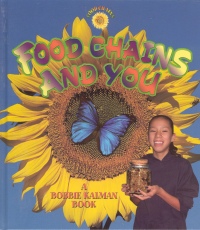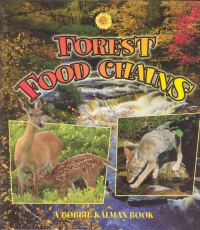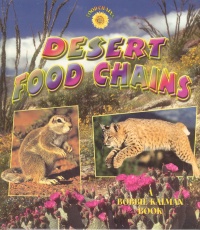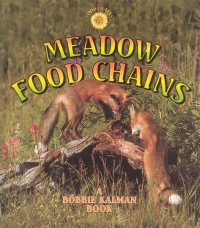| ________________
CM . . .
. Volume XI Number 14 . . . . March 18, 2005
excerpt:
In this series, readers will examine a number of food chains and webs in different habitats and will learn how food chains affect humans. Each book consists of 14 short chapters, a table of contents and a very brief glossary and index. With the exception of terms specific to food chains, such as "producers," "consumers," "opportunistic feeders" and "detritus food webs," the vocabulary is generally quite simple and easy for students to comprehend. All of the books contain an abundance of excellent colour photographs and diagrams to suit the text and to further the reader's understanding of the concepts. Borders, made up of tiny pictures pertaining to each book's theme, appear along the top of each page. In Food Chains and You, readers will learn how plants make energy and the relationships between producers and primary and secondary consumers (herbivores and carnivores). The text explains how scavengers, opportunistic feeders and decomposers contribute to the food web. Other topics include the benefits of eating fresh food over processed food, the various parts of plants that humans eat, and the threat to food chains by humans' use of pesticides and over-hunting and fishing. Forest Food Chains begins with the definition of a forest, types of trees and different kinds of forests. This title focuses on food chains in temperate forests (those in climates that are cold for part of the year and warm for part of the year). Also featured are plants' and animals' adaptations to seasonal changes, forest population control and endangered forests. The Sonoran Desert is the locale described in Desert Food Chains. Once again, adaptations of plants and animals -- short roots, ability to store water, hunting at night -- are highlighted. Estivation is a new term introduced in this book. Though meadows can be anywhere, Meadow Food Chains looks at meadows that grow on the edges of forests. Sandy loam soil determines the types of plants which thrive in these meadows, consequently, the kinds of animals as well. Readers will learn about tertiary consumers (carnivores that eat other carnivores) and animals' diets which change with the seasons. Individually, the titles in this series are very good. However, a great deal of the information is repeated in each volume, therefore, purchasers would not need to buy the entire series. Recommended. Gail Hamilton is a teacher-librarian at Bird's Hill School in East St. Paul, MB.
To comment
on this title or this review, send mail to cm@umanitoba.ca.
Copyright © the Manitoba Library Association. Reproduction for personal
use is permitted only if this copyright notice is maintained. Any
other reproduction is prohibited without permission.
NEXT REVIEW |TABLE OF CONTENTS FOR THIS ISSUE
- March 18, 2005.
AUTHORS
| TITLES | MEDIA REVIEWS
| PROFILES
| BACK ISSUES
| SEARCH | CMARCHIVE
| HOME |



